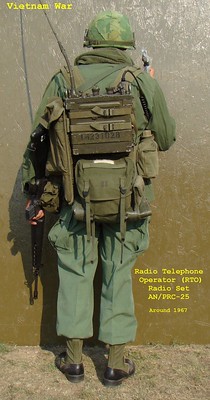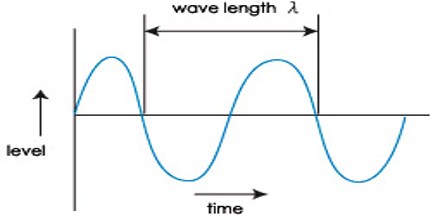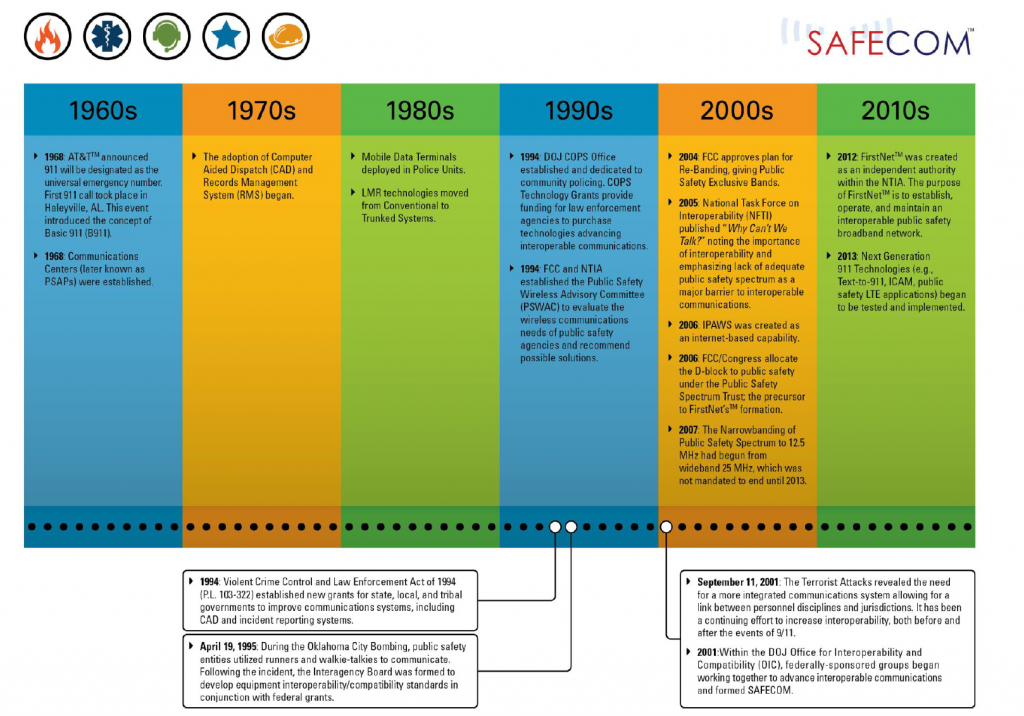How Radios Work
Published .

The Radio Wave
The basic building block of radio communications is a radio wave. Like waves on a pond, a radio wave is a series of repeating peaks and valleys. The entire pattern of a wave, before it repeats itself, is called a cycle. The wavelength is the distance a wave takes to complete one cycle. The number of cycles, or times that a wave repeats in a second, is called frequency. Frequency is measured in the unit hertz (Hz), referring to a number of cycles per second. One thousand hertz is referred to as a kilohertz (KHz), 1 million hertz as a megahertz (MHz), and 1 billion hertz as a gigahertz (GHz). The range of the radio spectrum is considered to be 3 kilohertz up to 300 gigahertz.
A radio wave is generated by a transmitter and then detected by a receiver. An antenna allows a radio transmitter to send energy into space and a receiver to pick up energy from space. Transmitters and receivers are typically designed to operate over a limited range of frequencies.

Radio waves travel in waves, much like the waves of the ocean. They move (or oscillate) up and down in a uniform motion. Just imagine for a moment if you held a piece of string in your hands with one end in each hand and you pulled it apart tightly. The string would move up and down rapidly, and this is very similar to how radio waves oscillate through the air. The amount of time it takes for the string, or a radio wave, to move from its top position to its bottom position and up again to its original position is called its cycle. The amount of distance that a radio wave moves in one cycle is called its wavelength. The number of cycles in one second is the radio wave’s frequency.
Factors Associated With The Transmission of Radio Waves
One of the most important concepts for all ham radio operators is propagation. Propagation is the process of radio signals traveling through the air, bouncing from surface to surface as it travels to radio antennas. Hams will closely monitor the atmosphere for storms, weather conditions, solar flares, and other atmospheric conditions that affect the transmission of radio signals (or the propagation of radio signals) through the air. Weather can play a very important role in the effectiveness of a radio signal, and this is an especially important concern for those ham radio operators who engage in professional emergency services. Having the right antenna is an especially important concern for most radio operators.
The Radio Spectrum
The radio spectrum is the small section of the Electromagnetic Spectrum devoted to radio transmission. When you tune your radio to a specific station, you are choosing a specific frequency that is contained within the radio spectrum. All of these different frequencies are grouped together into specific types of frequencies, and these groupings are called bands. So, for example, there is the AM band, which contains signals from AM radio stations. Bands are a very important concept in ham radio so we will look at the four main segments (or bands) of frequencies.
- Shortwave or High Frequency Radio waves traveling in this band are intended for AM radio stations, “ship-to-shore” and “ship-to-ship” communication, several military frequencies, the Citizens Band, and several different ham radio bands are contained within this band.
- Very High Frequency (VHF) This band includes television channels 2 through 13, all FM radio stations, several ham radio bands, some military frequencies, and some other commercial radio frequencies.
- Ultra High Frequency (UHF) This band includes TV channels 14 and higher, two Ham radio bands, cell phones, and some military frequencies.
- Microwave This band includes GPS signals, wireless telephones, WiFi networking signals, several ham radio bands, and, yes, your microwave oven.
The Transceiver
What EMS personnel would typically refer to as a radio would actually be called a transceiver. A piece of equipment that receives a radio signal and outputs the signal to a speaker (also commonly referred to as a radio) is a receiver. A transmitter is a device that generates radio waves. When you put the two together, you get a ‘transceiver’.

History of Public Safety (Police) Radio
| Date/Year/Decade | Description |
| 1970 | The use of Telemetry Applications by Emergency Medical Services from field to hospital was introduced. |
| 1970s | Establishment of Enhanced 911 (E911) services including 911 selective routing, Automatic Location Information (ALI), and Automatic Number Identification (ANI). |
| 1980s | Cellular 1G Network was developed and deployed. |
| January 13, 1982 | The Air Florida Flight 90 Crash used Washington Area Fire Mutual Aid Radio System and Police Mutual Aid Radio System networks, Washington Area Warning Alert Systems were used but insufficient. |
| 1989 | Project 25 (P25) suite of digital standards for conventional and trunked public safety radio systems developed, promulgating a variety of requirements which enhance operations and interoperability. |
| 1990s | Cellular 2G Network was developed and deployed. |
| 1990s | Geographic Information System (GIS) began to be incorporated to support 911, CAD, RMS, and Tactical Mapping requirements in communications centers and PSAPs. |
| 1996 | Federal Communications Commission (FCC) issued the Wireless Enhanced 911 Rules to address the new technologies that had to be created in order to provide E911 services to all wireless callers. Implemented in two phases: Phase 1: Within six months of a valid request by a PSAP, wireless carriers had to deliver the 911 caller’s voice and originating cell site location to the most appropriate PSAP.Phase 2: Phase II required wireless carriers, as of October 1, 2001 and within six months of a PSAP request for location information, to improve the location information used for call routing and caller location by providing the 911 system with the latitude and longitude of callers. Carriers were allowed to choose handset- based location technology using Global Positioning Systems (GPS)—or similar technology within individual wireless phones—or networked-based location technology using cell-tower triangulation. |
| 1991 | Mobile Broadband/Data was created. It allows wireless internet access through a portable modem. |
| 1996 | Nextel launches their iDEN (push-to-talk) network; a concept that would lay the foundation for mission-critical communications over cellular networks instead of the traditional LMR systems. |
| 1997 | Emergency Alert System (EAS) was created. This replaced the legacy EBS as noted for the Cuban Missile Crisis, moving from analog to digital alerting capabilities and Common Alerting Protocol. |
| 1998 | Wireless Sensors and Machine-to-Machine (M2M) capabilities (i.e., border control & security/central stations alarm systems) were implemented. |
| Date/Year/Decade | Description |
| 1999 | Portable Fingerprint Scanners were invented, primarily for Law Enforcement. |
| 1999 | Public Safety Act of 1999 officially established 911 as the nation’s emergency calling number. |
| 2000s | Cellular 3G Network was developed and deployed. |
| 2000s | Cellular Data Networks roll out vs. their traditional voice networks. |
| August 14, 2003 | The Northeast Blackout was a reminder to have backup communications systems in place and has influenced continuity measures for emergency response personnel. |
| 2005 | The transition from Public Switched Telephone Network (PSTN) to Internet Protocol (IP) begins. |
| August 29, 2005 | Hurricane Katrina saw the use of Public Safety Wireless Network Program audio matrix systems in Baton Rouge and New Orleans. |
| 2006 | Inter RF Subsystem Interface (ISSI) Connectivity was implemented. |
| 2009 | Smart Building Systems with on scene accountability tactical applications began to be developed and integrated to interact with jurisdictional CAD systems. |
| 2010s | Cellular 4G Network was developed and deployed. |
| 2010s | Video to include Mobile and Airborne uses with Video Switching (surveillance, video analytics) increasing over the decade. |
| 2010s | Augmented Intelligence Tools starting to be developed and implemented. |
| April 20, 2010 | The Deepwater Horizon Oil Spill led to the development of the Gulf Coast Wireless Information Network (Gulf WIN), a 700/800 MHz interoperable radio network featuring fingertip roaming throughout the Gulf Coast region, this connected the U.S. Coast Guard with state and local responders. |
| April 15, 2013 | During the Boston Marathon Bombing, public safety personnel maintained interoperable communications by using cache radios and building a super patch from six radio networks. |
| September 16, 2013 | The Washington Navy Yard Shooting showed a use for social media during an incident. Multiple entities (the U.S. Navy, local public safety agencies, DC Mayor’s office, etc.) used platforms such as Twitter and Facebook to provide updates on the evolving situation. |
